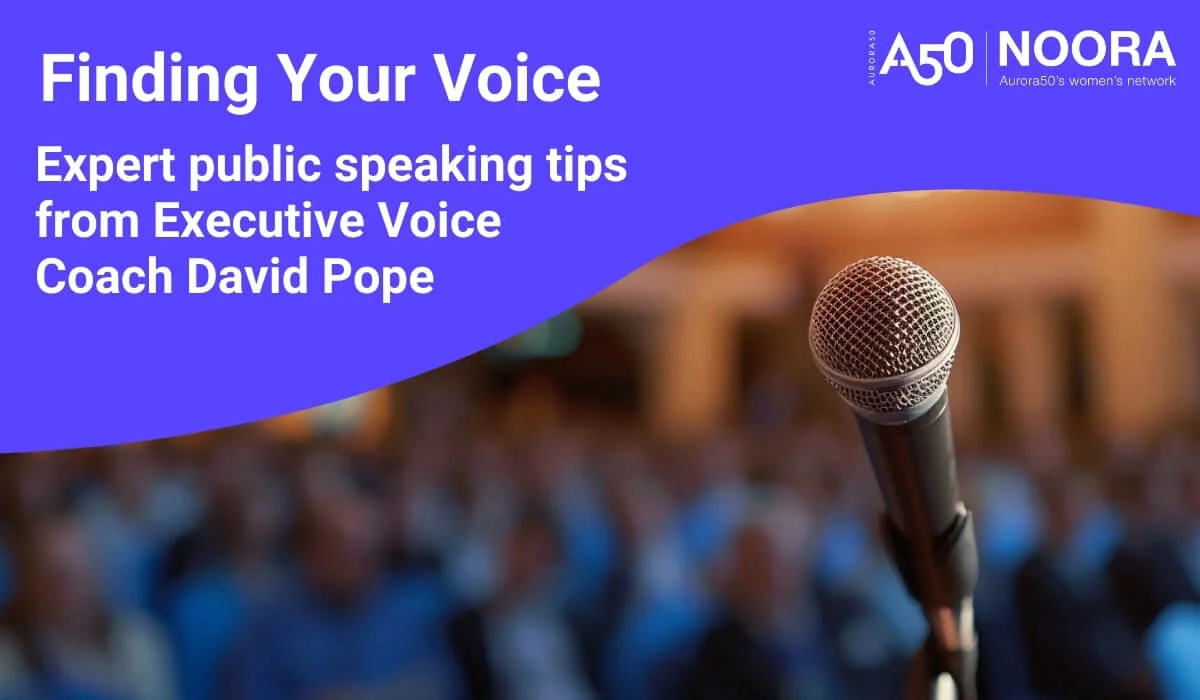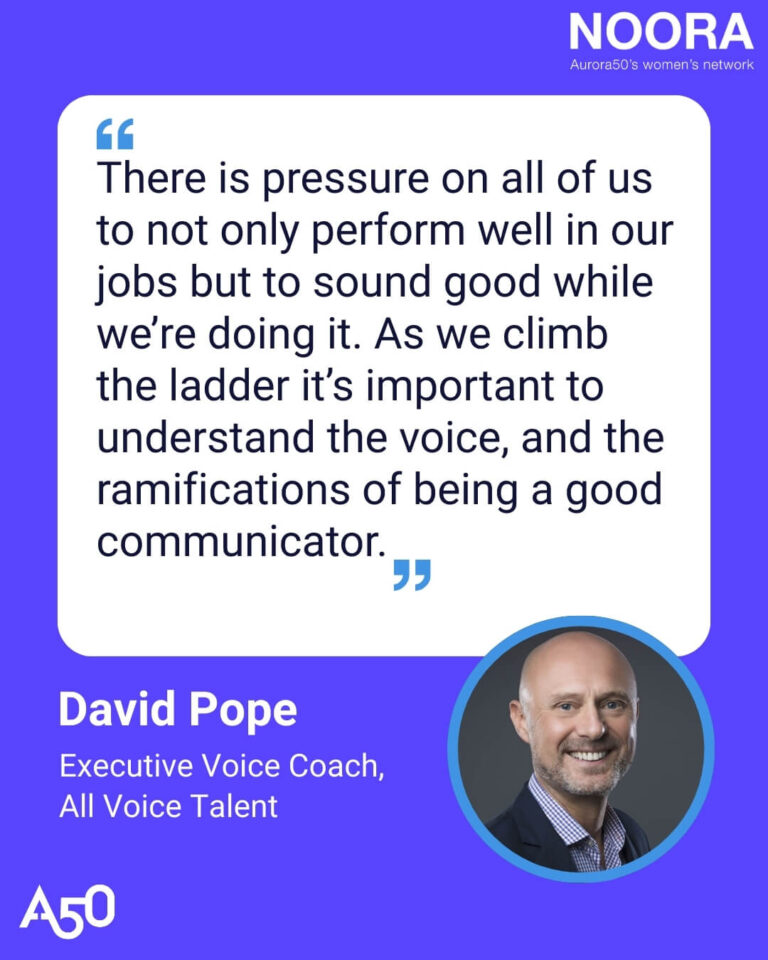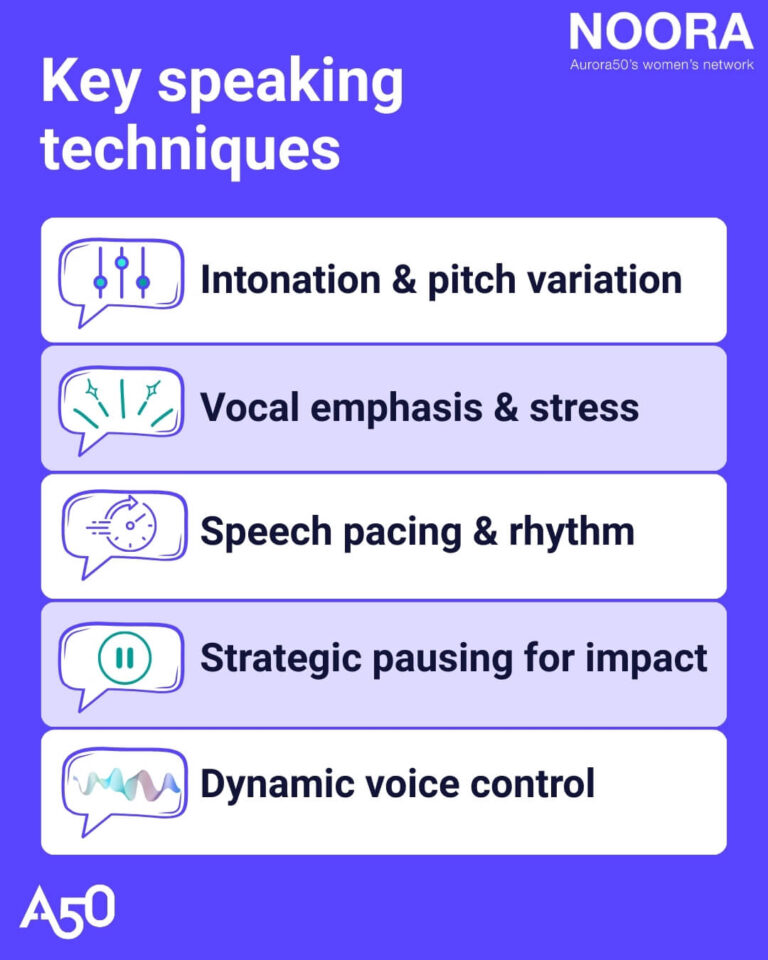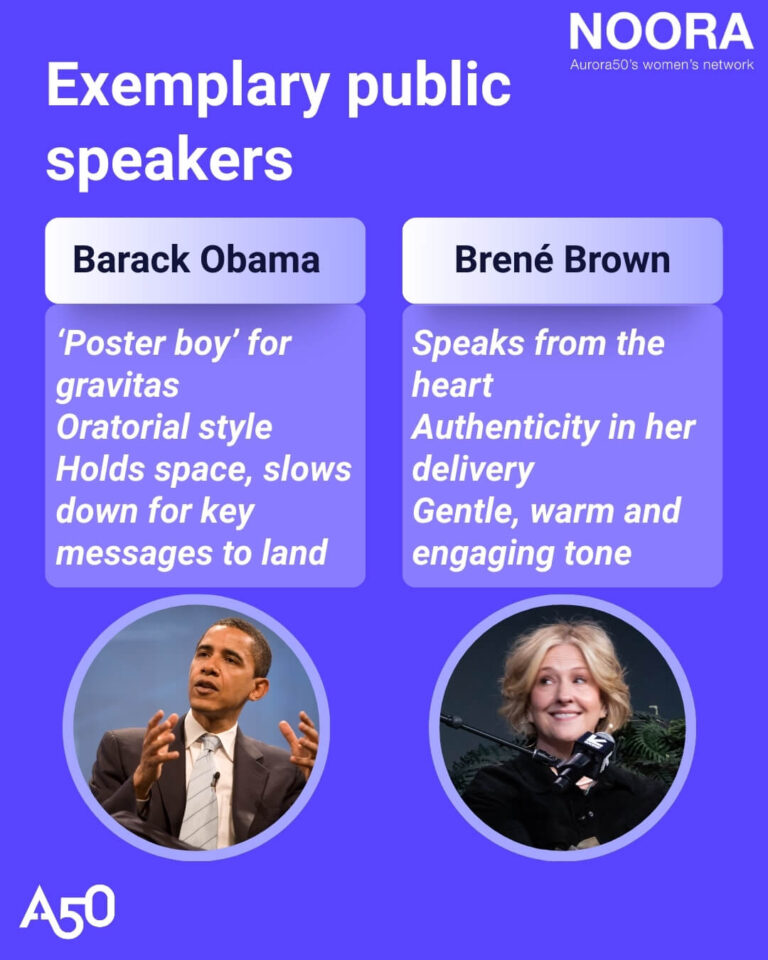





Small changes in how you speak can have a big impact on how people perceive you in professional settings. We spoke to David Pope, Executive Voice Coach at All Voice Talent, who works with business leaders globally to help them develop effective public speaking skills and find their authentic voice, and who recently ran a workshop for Aurora50’s NOORA members.
A: Public speaking is not just standing in front of a group of people delivering speeches.
Any form of communication where you’re effectively showing up is public speaking – panel interviews, speaking on boards, keynote presentations, conferences, being a moderator or on a panel, podcasts and even networking events.
It’s about that strength, energy, warmth and engagement you bring to the communication piece. Effective public speaking skills are essential for career advancement and leadership development.
There is pressure on all of us not only to perform well in our jobs but to sound good while doing it. As we climb the ladder it’s important to understand the voice, and the ramifications of being a good communicator.
The good news is we don’t have to make drastic changes – even small changes can have a big impact. So, for example, If your voice sounds just a little bit stronger, people begin to see you as a stronger person.

A: Understanding the foundation of the voice is crucial for confident public speaking. This involves vocal training exercises around posture, diaphragmatic breathing, voice projection and articulation.
It’s about having volume in your voice to help you speak with authority. You also need clarity in the way that you deliver your message.
Speaking clearly centres around good articulation, which is basically enunciation and pronunciation – an essential skill for being a good public speaker.
For women climbing the leadership ladder, it’s especially important to understand the voice and the ramifications of being a good communicator when speaking in public. This is why I work a lot with women’s groups such as DBWC (Dubai Business Women’s Council), JP Morgan’s Women on the Move, Goldman Sachs, Women In Law, Risky Women (for women in risk and compliance), WISTA (for women in maritime) and many more – and now NOORA.

A: Vocal variety is what turns a good speaker into a great public speaker. This includes key speaking techniques:
When you master these public speaking elements, you create a more dynamic and engaging presentation style that captures audience attention.
This is particularly important in leadership positions and professional speaking engagements where command of the room is essential for persuasive communication.
A: Obama is often called the ‘poster boy’ for gravitas in speech. He’s good because he is slow but not ‘boring-slow’. A lot of people make that mistake – they think having a slow, steady pace all the time has gravitas. What we need is to vary the pace.
Obama holds space, slows down for key messages to make them land, then speeds up, then slows down again. Notice how he uses pauses – his pausing and pacing are very effective. He’s had years of voice coaching and that’s why he comes across as so natural – he’s got the foundation.
Another exemplary speaker is Brené Brown. She speaks from the heart, with authenticity in her delivery. Obama has gravitas – pitch, resonance and oratorial style. The key thing with Brené Brown is authenticity.
She’s really exuding that, with a tone that’s gentle, warm and engaging. She’s also using pacing and pausing to great effect.

A: One of the most important things is eye contact. To have impact and authority at the beginning of meetings, look directly into the camera because that engages people from the get-go. That shows your authority and sets the scene for the meeting.
We also need to be conscious of aesthetics and camera presence. Is your head cut off? Are you tipping to one side? People do this and aren’t aware. The whole image is really important.
Sit a little bit further back to allow your hands to come into the screen if you want to use them – so you don’t end up with tiny ‘T-Rex hands’. Having space allows you to engage properly.
This is about holding the room and commanding attention – not just in a big physical space, but from that tiny little screen we’re looking at.
A practical tip: To help yourself look at the camera instead of the screen, draw a big arrow on a post-it note and stick it by your camera. Every time you switch on the screen and see the sticker with an arrow, it forces you to look at the camera.
A: First, keep your language simple. Don’t try to use overly complex vocabulary – keep it simple.
Second, keep your messaging brief as well. If people don’t understand, they can always ask for clarification.
Third, work on articulation. If you’re speaking to regional or global teams and have specific technical terms you must use (like AUM or ‘assets under management’), practice those phrases beforehand.
Treat them like tongue twisters and do a targeted warm-up with acronyms and terms: for instance, keep saying “assets under management, assets under management” and slow the pace. Get your mouth moving so when you’re on the call, you’ve warmed your mouth up with key vocabulary.
A: There’s a slight disconnect about this word storytelling’ – people think it means a long, convoluted story. No. If something sparks emotion and contains a learning, that can be a story.
Business stories should always have an outcome, objective, or goal – to inspire and influence an audience. They help you connect with people on a human level by showing vulnerability and humanity. We can all tell stories.
Stories help sell products or services (think about how advertising does this), win customers and clients and make pitches more effective. Begin a pitch with an origin story rather than dry facts. The bottom line is that stories make facts and data more interesting.
Business stories need positive outcomes because you’re trying to get somebody to do something or buy into your idea. Stories of showing resilience, courage, or transformation are particularly powerful.
Remember: voice, presence, delivery and storytelling – put all these together and you’re a great communicator.
Find out more about David Pope’s coaching programmes, workshops and online video courses at allvoicetalent.com/.
NOORA is the Aurora50 community for talented and ambitious corporate women in the GCC who lead with impact. You can purchase a corporate package or buy membership as an individual. Find out more at aurora50.com/noora.
![[A50 template] From left to right: cybersecurity specialist Dr Hoda Alkhzaimi; HE Sarah Al Amiri, chair of the UAE Space Agency; Salma Al Hajeri, one of the first women to graduate from Abu Dhabi’s Petroleum Institute; Aisha Al Mansoori, the first female Emirati captain in a commercial airline; aspiring scientist Alia Al Mansoori; and Nora Al Matrooshi, the first Arab woman astronaut|[A50 template] Aisha Al Mansoori, the first female Emirati captain in a commercial airline at Etihad. Photo credit Etihad|[A50 template] Alia Al Mansoori, aspiring Emirati scientist. Photo credit Alia Al Mansouri, Facebook|[A50 template] Dr Hoda Alkhzaimi, Director of the Center of Cyber Security in New York University Abu Dhabi. Photo credit Aurora50|[A50 template] HE Sarah Al Amiri, chair of the UAE Space Agency. Photo credit WAM|[A50 template] Nora Al Matrooshi, the first Arab woman astronaut. Photo credit WAM|[A50 template] Mubadala's Salma Al Hajeri, Salma Al Hajeri, one of the first women to graduate from Abu Dhabi’s Petroleum Institute. Photo credit Mubadala [A50 template] From left to right: cybersecurity specialist Dr Hoda Alkhzaimi; HE Sarah Al Amiri, chair of the UAE Space Agency; Salma Al Hajeri, one of the first women to graduate from Abu Dhabi’s Petroleum Institute; Aisha Al Mansoori, the first female Emirati captain in a commercial airline; aspiring scientist Alia Al Mansoori; and Nora Al Matrooshi, the first Arab woman astronaut|[A50 template] Aisha Al Mansoori, the first female Emirati captain in a commercial airline at Etihad. Photo credit Etihad|[A50 template] Alia Al Mansoori, aspiring Emirati scientist. Photo credit Alia Al Mansouri, Facebook|[A50 template] Dr Hoda Alkhzaimi, Director of the Center of Cyber Security in New York University Abu Dhabi. Photo credit Aurora50|[A50 template] HE Sarah Al Amiri, chair of the UAE Space Agency. Photo credit WAM|[A50 template] Nora Al Matrooshi, the first Arab woman astronaut. Photo credit WAM|[A50 template] Mubadala's Salma Al Hajeri, Salma Al Hajeri, one of the first women to graduate from Abu Dhabi’s Petroleum Institute. Photo credit Mubadala](https://aurora50.com/wp-content/uploads/2023/05/photo-collage-copy.jpg)
To celebrate the UN’s International Day of Women and Girls in Science, we highlight six women at the forefront of science, technology, engineering and mathematics (STEM) in the UAE.

The project begins with a pilot to make Yas Island an inclusive zone in 2025; Abu Dhabi plans to become a WHO-accredited age-friendly city.

The Hidden Disabilities Sunflower is an awareness tool designed to help individuals with hidden disabilities signal their need for support.

